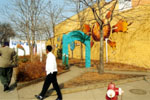|
|
home | about Phillips | Kids and Family | Health and Wellness | Community Organizing | Resources |
|
Early Phillips Area Defined by Railroads and Industry by Wizard Marks. This article first appeared in The Alley in May, 1990.
The creation of neighborhoods, particularly before the automobile was in common use, was largely a function of where industries were located, where streetcar lines were developed and where developers decided to build. Industries, in turn, are located where transportation is available to ship and receive goods and raw materials. Phillips Neighborhood exists principally as a result of its proximity to the Southtown Yards (formerly belonging to the Milwaukee Road Railroad), to the development of a mass transit system, and to those real estate developers who bought up farm land on what was then the edge of town and built housing here.
The thirty years 1860 through 1890 were the most rapid period of growth in Minneapolis' history. In 1872 the city's corporate boundary was still 24th St. and the northern boundary of the City of Richfield was Lake St. By 1883, the southern corporate line of Minneapolis was 46th St., and by 1887 the city had expanded to 54th St. The 1890 census set the population of Minneapolis at 164,738, sixty-four times the number of people in 1860.
The western half of what is now Phillips was home to some of the city's wealthiest families: Pillsburys, Washburns, Peaveys, Turnblads, Crosbys, Morrisons, and Stevens. The mansion district which ran from 10th Av. west to Blasidell Av. was developed by them and for them. The eastern side of the neighborhood was built for working people and industries.
In the 1880's the near southside, running from the river to 24th St. and 10th Avenue housed "Bohemians, Blacks, Scandinavians, Germans, Irish and Jews." Tenth Street to Franklin, along the Milwaukee Road tracks, housed Blacks. South of Franklin near Cedar housed immigrant Russian and Rumanian Jews. For many years a Jewish temple stood where the Hiawatha overpass now crosses Franklin Avenue. The neighborhood was also home to early Irish, English and Scottish immigrants. Until the 1930's, 15-25% of these homes were without electricity, running water and indoor plumbing. There were few markets, parks, or boulevards.
In the depths of the Great Depression in 1934, the situation had deteriorated significantly. On a city map in Legacy of a Working City, the eastern side of Phillips, along with parts of Seward were categorized as slum housing and labeled for "foreign born" and "Negroes." Two small sections of the neighborhood were called a "rooming house district" and a "residential lower middle class" district, while the western section was divided between "transitional business/light industry" and "main apartment house area." Over 25% of the neighborhood's people were unemployed in 1934, 75% of the houses were rental housing, and 20% of the housing was considered uninhabitable. Those statistics aren't much different today.
Major industries determined where the work would be. By the 1880's the Milwaukee Road, Minneapolis Moline, and Abbott Northwestern were already in their developmental stages and they would set the stage for the development of ancillary industries in the neighborhood as well as attract people to housing within a short distance of their work places.
Though Phillips Junior High was built in the 1920's, the area was not called the Phillips neighborhood until the Model Cities program of the 1960's created the current neighborhood designations. Early in the history of the city, this area was referred to as the Near Southside and later simply the Southside. Most people referred to their neighborhood by the nearest major street intersection, i.e., Chicago and Franklin or Cedar and Lake.
|
|
PNN Quicklinks |
|
|
|
Featured image |
|
Organizations |
|
|
|
Elected officials |
|
|
|
Phillips life |
 |
|
|